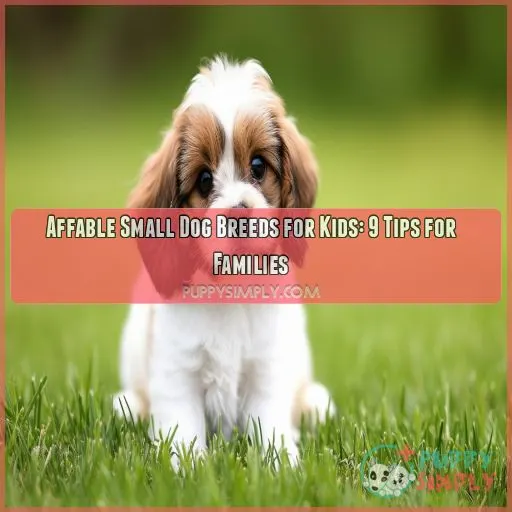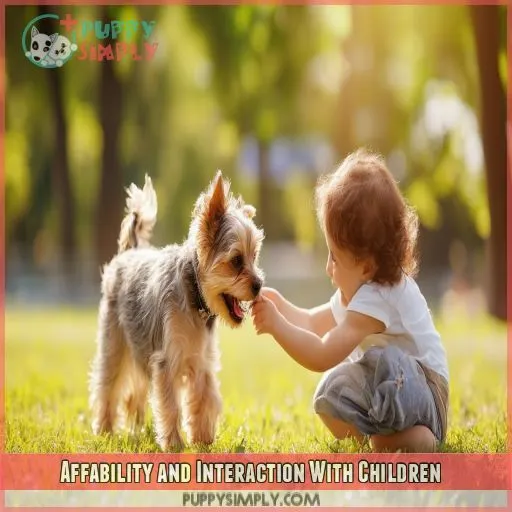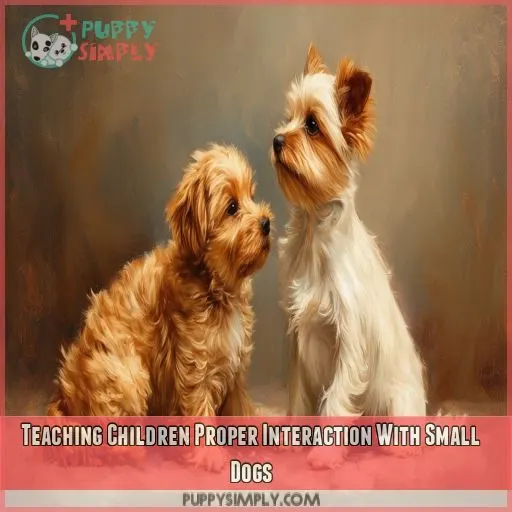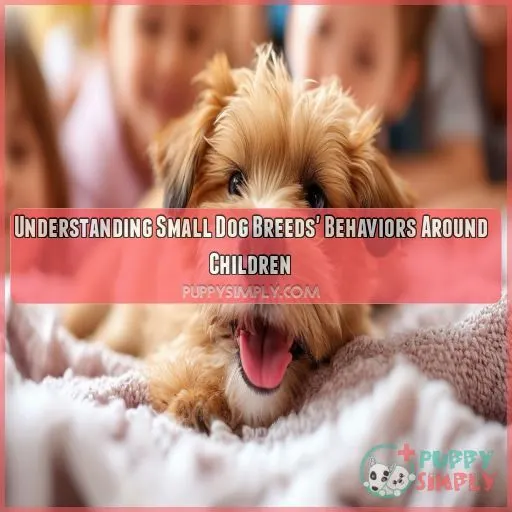This site is supported by our readers. We may earn a commission, at no cost to you, if you purchase through links.

So, you’ve decided to get a dog for your kids. You’ll want a dog that’s gentle, patient, and energetic.
Some small dog breeds are fragile and can get anxious around kids, while others are playful and affable.
This guide will help you choose the right small dog breed for your family, covering everything from temperament and energy levels to training methods and long-term compatibility.
Table Of Contents
- Key Takeaways
- Best Small Dog Breeds for Families With Children
- Affability and Interaction With Children
- Factors Influencing Affability in Small Dog Breeds
- Teaching Children Proper Interaction With Small Dogs
- Key Qualities of Small Dog Breeds Suitable for Kids
- Understanding Small Dog Breeds’ Behaviors Around Children
- Ensuring Long-Term Compatibility and Well-Being
- Small Dog Breeds Suitable for Specific Circumstances
- Small Dog Breeds’ Affability for Different Age Groups
- Training Methods for Kids and Small Dogs
- Frequently Asked Questions (FAQs)
- Which small dog breeds are best for families with children?
- Do small dog breeds do well with small children?
- What breeds of dogs are aloof to children?
- Which dogs have good behavior around children?
- What are some small, friendly dogs for first-time owners?
- Are there small dog breeds that are good with babies?
- How do I know if a small dog is right for my family?
- Are small dogs easier to train than large dogs?
- What are some small dog breeds that get along with kids and other pets?
- Conclusion
Key Takeaways
- There’s a whole host of small, friendly dog breeds that are perfect for families with kids, including Beagles, Pugs, Cavalier King Charles Spaniels, and more.
- It’s important to teach your kids how to interact with small dogs safely and respectfully, including gentle handling and recognizing warning signs.
- Socialization is key to a dog’s affability; exposing them to different people, places, and situations makes them more adaptable and less likely to be fearful.
- When choosing a small dog breed, consider not just temperament and energy levels but also grooming requirements and the dog’s compatibility with your family dynamics and lifestyle.
Best Small Dog Breeds for Families With Children
When choosing a small dog breed for your family, it’s important to evaluate a variety of factors, including temperament, size, and energy level. Some of the best small dog breeds for families with children include the Beagle, Pug, Cavalier King Charles Spaniel, Boston Terrier, and Staffordshire Bull Terrier.
Beagle
Beagles are a gentle and even-tempered breed, making them a great choice for families with children. They’re loving, active, and good with kids, and their size is compatible with most homes. Beagles are also known for their playful and affectionate temperament, which can help create a joyful family environment.
Pug
Pugs are goofy and sociable, making them one of the best small dog breeds for families with children. However, some factors should be kept in mind:
- Health Issues: Pugs often suffer from brachycephalic syndrome, which can lead to breathing problems and require extra care.
- Training: While Pugs are intelligent, they can be stubborn and require consistent, positive reinforcement training.
- Grooming: Their short coat is easy to maintain, but their facial wrinkles need regular cleaning to prevent skin infections.
Cavalier King Charles Spaniel
The Cavalier King Charles Spaniel is a gentle, playful, and affectionate breed that’s perfect for families. They’re easily trained and get along well with children.
| Breed Characteristics | Cavalier King Charles Spaniel |
|---|---|
| Health Concerns | N/A |
| Temperament Analysis | Gentle, playful, affectionate |
| Training Recommendations | Easily trained |
Boston Terrier
Boston Terriers are friendly, enthusiastic, and portable, making them great small dogs for families. Here are some key points about this breed:
- Boston Terriers are known for their silly and sociable temperament, always up for a good time.
- Their short coats make grooming a breeze, which is a plus for busy families.
- These dogs are generally healthy and trainable, but remember that every dog is an individual with unique needs.
- Setting clear boundaries and providing consistent training will help your Boston Terrier thrive in your family.
Staffordshire Bull Terrier
The Staffordshire Bull Terrier, or ‘Staffy’ as they’re affectionately known, is a loyal and devoted breed with a muscular build. They’re active, social, and loving, making them ideal for families with kids.
| Staffy Stats | Details |
|---|---|
| Breed Characteristics | Muscular, social, loving |
| Exercise Requirements | Active, requiring daily walks and playtime |
| Health Concerns | Generally healthy, but prone to skin allergies and joint issues |
| Potential Allergies | Yes, prone to skin allergies |
| Lifespan | 12-14 years |
Affability and Interaction With Children
Affability and positive interactions between small dog breeds and children are essential for harmonious family life. Respecting the dog’s space, providing adult supervision, maintaining hygiene, practicing safe feeding, and understanding dog behavior are key aspects to reflect on when fostering a healthy relationship between your children and their furry friends.
Respecting Dogs
Teaching your kids to respect dogs is paramount for their safety and the dog’s well-being. This includes understanding dog boundaries, like when they want to be left alone, and knowing how to approach and interact with dogs safely.
Adult Supervision
Adult supervision is essential for safeguarding the safety and well-being of both your children and your dog. Always supervise their interactions, especially when they’re getting to know each other. This will help you guarantee their behavior and make sure things don’t get too rowdy or rough.
Hygiene
Hygiene is an important aspect of dog ownership, especially for gentle dog breeds that are prone to allergies. Regular grooming, including bathing habits, nail trimming, and ear cleaning, can help keep your furry friend healthy and happy.
Safe Feeding Practices
Safe feeding practices are essential for your dog’s health and energy level. Establish consistent feeding schedules and store dog food securely. Limit treats and always provide fresh water.
Understanding Dog Behavior
Understanding dog behavior is essential to ensuring a harmonious relationship between your family and your furry friend. Dogs communicate through body language and social cues, so it’s important to learn about dog psychology and pack dynamics to interpret their signals effectively.
Factors Influencing Affability in Small Dog Breeds
When selecting a small dog breed for your family, it’s essential to take into account various factors that impact a dog’s compatibility. These include temperament, size, socialization, energy level, and grooming requirements.
Temperament
Temperament plays a pivotal role in determining a dog’s affability, especially with small dog breeds that are popular among families with kids. It’s essential to examine breed-specific traits, health considerations, and alert behaviors. For example, you may prefer a dog that’s gentle and even-tempered like a Beagle, or perhaps one with a goofy and sociable nature like a Pug.
Size
Size is an important consideration when choosing a dog, influencing housing requirements and climate adaptability. For example, smaller dogs may be better suited for apartment living, while larger dogs typically need more space. Similarly, certain breeds may be more tolerant of colder or hotter climates, impacting their comfort and energy levels.
Socialization
Socialization is key to a dog’s affability.
A well-socialized dog has been exposed to different people, places, and situations, making them more adaptable and less likely to be fearful or aggressive.
When choosing a small dog breed for your family, consider the home environment and your child’s temperament.
Some breeds are naturally more social and outgoing, like the Pug and Boston Terrier, while others may require more supervision and training to make them comfortable and safe around children.
Energy Level
When choosing a small dog breed for your family, consider their energy level and exercise requirements. Some dogs have higher activity levels and need lots of outdoor activities, while others are content with indoor play.
Grooming Needs
Grooming maintenance varies by coat type. Short-coated breeds like Boston Terriers shed minimally and require less brushing. Poodles need frequent grooming due to their continuously growing hair.
Teaching Children Proper Interaction With Small Dogs
Teaching your children how to interact with small dogs is essential for their safety and the dog’s well-being. This involves respectful play, proper handling, consistency in training, identifying warning signs, and understanding the responsibility of caring for a dog.
Proper Handling
Teaching children how to properly handle a small dog is essential. Start with basic handling techniques, such as gentle petting and appropriate age ranges for different interactions. Always supervise playtime to prevent accidents and encourage positive socialization strategies.
Respectful Play
Respectful play is key to fostering a positive relationship between your children and your small dog. Supervised interactions ensure age-appropriate play, where children learn to interact with dogs safely and respectfully. Leash training, reward systems, and calming techniques are also important tools to teach your children.
Consistency in Training
Consistency in training methods is key to ensuring your small dog understands and responds well to commands. Here are some tips to achieve this:
- Keep it regular: Practice training sessions at consistent times each day, even if they’re brief.
- Age appropriateness: Tailor your training methods to your child’s age and ability. For younger kids, focus on basic commands and safety precautions to prevent potential hazards.
- Make it fun: Engage your child by incorporating games and treats into training sessions.
- Positive reinforcement: Always use positive reinforcement techniques, like treats or praise, to encourage desired behaviors.
- Patience is key: Remember that both your child and your dog are learning, so be patient and consistent in your approach.
Identification of Warning Signs
Children must learn to recognize warning signs in a dog’s behavior, like growling, baring teeth, or a tucked tail. These signals indicate a dog’s discomfort and can help prevent bites. Adult supervision is key to ensuring child safety.
Responsibility for Care
Teaching your children about responsibility for care is essential for their development and the well-being of your small dog. Assign age-appropriate chores and emphasize safety precautions and communication strategies to foster a harmonious family dynamic.
Key Qualities of Small Dog Breeds Suitable for Kids
When choosing a small dog breed for your family, it’s crucial to evaluate key qualities beyond their adorable looks. The appropriate breed should have the suitable temperament, be the correct size for your family’s lifestyle, be socialized and connected to your family, have an energy level that matches your family’s activity level, and have grooming requirements that you can handle.
Temperament Traits
When choosing a small dog breed suitable for kids, it’s important to consider the temperament traits that promote compatibility and safety. Here are three key aspects to consider:
- Breed Compatibility: Choose breeds known for their gentle, playful, and sociable temperaments, such as Beagles, Pugs, and Cavalier King Charles Spaniels.
- Child Development: Dogs with a compatible temperament can positively impact a child’s development, teaching them responsibility, empathy, and social skills.
- Safety Precautions: Make sure the dog’s temperament aligns with the energy and dynamics of your family to prevent accidents or unintended harm.
Size and Physical Compatibility
When considering a small dog breed, it’s important to think about size and physical compatibility. This includes housing requirements, climate adaptability, safety concerns, exercise needs, and health considerations.
Socialization and Attachment
Socialization and attachment are essential aspects of fostering healthy relationships between dogs and children. Different breeds exhibit specific behaviors and attachment styles, so understanding these nuances is necessary for harmonious dog-child interactions.
Exercise and Energy Level
When selecting a small dog breed for your family, it’s crucial to take into account the energy levels and exercise requirements of both the dog and your children. Here are some key factors to keep in mind:
- Exercise routines: Establish regular exercise routines for your dog, including walks, playtime, and mental stimulation.
- Energy compatibility: Make sure the dog’s energy level matches your child’s activity level for optimal bonding.
- Suitable activity levels: Understand the appropriate activity levels for different breeds and your child’s age to ensure a good match.
- Breed suitability: Consider breeds known for their adaptability to different energy levels and exercise routines.
Grooming Requirements
When choosing a small dog breed for your family, consider the grooming requirements. Some breeds have high-maintenance coats that need frequent brushing and trips to the groomer. Others, like Boston Terriers, have short, easy-to-maintain coats. Hypoallergenic breeds are ideal if allergies are a concern.
Understanding Small Dog Breeds’ Behaviors Around Children
When choosing a small dog breed for your family, it’s important to understand how different breeds typically behave around children. Some dogs may be more aloof or less patient with kids, while others are known for their playful and affectionate nature.
Being able to identify warning signs and encourage positive interactions is key to fostering a safe and harmonious relationship between your children and their furry friends.
Aloofness to Children
Some small dog breeds may exhibit aloofness around children, necessitating careful oversight. Verify that you comprehend their body language and warning signs to prevent adverse interactions and guarantee child well-being.
Good Behavior Around Children
While some small dogs may be initially aloof, with proper small dog training, child supervision, and positive interactions, they can develop good behavior around children. Here are some tips to encourage positive behavior:
- Supervise interactions closely, especially with young children, to promote good behavior from both the dog and the child.
- Teach children appropriate hygiene precautions, such as washing their hands after playing with the dog.
- Encourage gentle and respectful play to foster a positive relationship between the dog and the child.
Warning Signs in Small Dog Breeds
Warning signs in small dog breeds can include behavioral differences, health concerns, and breed compatibility issues. Be mindful of genetic predispositions and socialization strategies that may impact their interactions with children.
Encouraging Positive Interactions
Encouraging positive interactions between your child and your small dog is essential for fostering a harmonious family relationship. Age-appropriate training for your child and consistent reinforcement of good behaviour for your dog are key components. Open communication and fostering patience in both your child and dog will also contribute to positive interactions.
Communication With Children
Children should be taught to understand a dog’s body language and respect their personal space. Supervision is essential to maintain dog safety and hygiene practices.
Ensuring Long-Term Compatibility and Well-Being
Ensuring long-term compatibility and well-being is paramount when choosing a small dog breed for your family. This involves considering factors such as regular veterinary care, adapting to family dynamics, implementing safety precautions at home, building trust and bonding with your dog, and maintaining consistent training.
Regular Veterinary Care
Regular veterinary care is essential for your dog’s long-term health and happiness. Here are some key aspects to focus on:
- Vaccinations: Stay up to date with core and non-core vaccinations to protect your dog from preventable diseases.
- Dental Care: Practice good dental hygiene, including regular brushing and professional cleanings, to maintain your dog’s oral health.
- Parasite Prevention: Work with your vet to develop a plan for preventing and treating common parasites like fleas, ticks, and heartworms.
- Grooming and Nutrition: Proper grooming and a balanced diet are essential for your dog’s overall health and well-being.
Adaptation to Family Dynamics
Ensuring your dog adapts to your family dynamics is key to long-term compatibility and well-being. Consider your home environment and use socialization techniques to help your dog settle in. Breed selection also plays a role here, as certain breeds may be more suited to your family’s unique dynamics.
Safety Precautions at Home
Safety precautions are essential to safeguard the well-being of both your children and your canine companion. Here are three key measures to implement:
- Install a fence to create a designated play area for your dog, preventing them from straying or encountering dangerous situations.
- Regularly inspect and manage your dog’s toys, removing any potential hazards like loose parts or toxic materials.
- Learn basic first aid for dog bites to effectively respond to any accidents that may occur, reducing the risk of infection and promoting healing.
Building Trust and Bonding
Building trust and bonding is essential for long-term compatibility and well-being. This involves pre-pet preparation, fostering relationships, and behavioral management.
| Pre-Pet Preparation | Research breeds, their needs, and your family’s ability to fulfill them. |
| Fostering Relationships | Encourage positive interactions and attachment between kids and dogs. |
| Behavioral Management | Understand and manage dog behaviors to maintain a harmonious relationship. |
Maintaining Consistent Training
Maintaining consistency in training is essential for long-term success. Establish regular training schedules, use reward systems, and focus on behavior modification techniques. Socialize your dog during training to reinforce positive behaviors in various environments.
Small Dog Breeds Suitable for Specific Circumstances
When selecting a small dog breed for your family, it’s crucial to evaluate specific circumstances, such as apartment living, allergies, outdoor activities, multiple pets, and special needs children. These factors will help determine the most appropriate breed for your unique situation, ensuring a harmonious and happy home for both your family and your furry friend.
Apartment Living
Apartment living with a small dog can be a cozy and enjoyable experience, as long as you choose the right breed for your circumstances.
Here are some factors to think about when selecting a small dog breed for your apartment home:
- Small dog size: Opt for breeds that are naturally small in size, such as the Beagle, Pug, or Cavalier King Charles Spaniel. They’ll have plenty of space to roam and play in your apartment.
- Apartment space: Consider the layout of your apartment. Is there enough room for a dog to comfortably move around and exercise? If space is limited, choose a breed that doesn’t require as much energetic play, such as a French Bulldog or a Havanese.
- Energetic play: If you’re an active person who enjoys taking your dog on walks and runs, choose a breed that matches your energy level, like the lively Rat Terrier or the spirited Welsh Terrier.
- Breed popularity: Popular small dog breeds for apartments include the Boston Terrier, known for their friendliness and portability, and the intelligent and loyal Boxer.
- Hypoallergenic breeds: If you or your family members have allergies, consider hypoallergenic breeds like the Poodle or the Schnauzer, which shed less dander and are easier on sensitive individuals.
Allergies
If allergies are a concern, some dog breeds are more likely to elicit allergic reactions, while others are deemed hypoallergenic. If you or your family experience respiratory issues or breed-specific allergies, it’s imperative to prioritize health concerns when selecting a dog.
Outdoor Activities
When selecting a small dog breed for outdoor adventures, take into account their energy levels and exercise needs. Make certain of compatibility with your lifestyle.
Multi-Pet Household
When adding a new dog to a multi-pet household, consider multi-species dynamics, breed compatibility, space management, routine maintenance, and potential conflicts.
Special Needs Children
Special needs children deserve the companionship of a furry friend. Consider their disabilities and sensory sensitivities when choosing a dog. Behavior modification and dog training can help create a harmonious match.
Small Dog Breeds’ Affability for Different Age Groups
When choosing a small dog breed for your family, it’s crucial to assess the age range of your children. Different breeds may be better suited to toddlers and preschoolers, school-age children, teenagers, young adults, or elderly family members.
Toddlers and Preschoolers
When it comes to toddlers and preschoolers, extra care is needed to make sure their safety around small dogs. Here are some key considerations:
- Toddler safety: Always supervise young children when they’re interacting with dogs. Teach them gentle handling and respect for the dog’s space.
- Preschooler interactions: Encourage gentle play and positive reinforcement for good behaviour.
- Child supervision: It’s important to always keep an eye on things, especially with toddlers who mightn’t understand boundaries yet.
- Age-appropriate training: Start early with socialisation and basic commands to set a strong foundation for a healthy relationship.
School-Age Children
As your kids grow, small dog breeds remain ideal companions. School-age children can grasp safety precautions and positive reinforcement techniques, involving them more in the dog’s care.
Teenagers
As your kids enter their teenage years, it’s crucial to take into account their evolving needs when choosing a dog breed. Factors like dog allergies, training, and setting boundaries become more significant.
Young Adults
As young adults gain independence, their canine companions become a source of comfort and companionship. Affable breeds for this age group include the gentle Beagle, playful Cavalier King Charles Spaniel, and the loyal Pug.
Elderly Family Members
Small dogs offer elderly family members companionship, health benefits, and socialization. They’re a great addition to elderly care and can even provide pet therapy.
Training Methods for Kids and Small Dogs
When embarking on the endeavor of training small dogs, it’s imperative to impart basic commands and employ techniques that reinforce positive behavior. Establishing clear boundaries and rules is also paramount, and engaging children in care activities can render the process more enjoyable and captivating for all involved.
Teaching Basic Commands
Teaching basic commands is an essential aspect of dog ownership and child socialization. Here are some tips to help you get started:
- Start with age-appropriate commands: Choose commands that are simple and suitable for your child’s age and the dog’s breed and temperament.
- Emphasize safety: Make sure your child understands the importance of gentle handling and consistent training techniques to avoid accidental harm to the dog or themselves.
- Be consistent: Consistency is key in dog training. Make sure everyone in the family uses the same commands and techniques to avoid confusion for both the child and the dog.
- Seek professional guidance: If you’re unsure where to start or encounter challenges, don’t hesitate to consult a professional dog trainer or behaviorist for personalized advice and support.
Positive Reinforcement Techniques
Positive reinforcement is key to training your dog and your kids. You can use clicker training and treat motivation to reward your dog for good behavior. This will help them learn and encourage positive interactions with your children.
Setting Boundaries and Rules
Setting boundaries and rules is essential for a harmonious home. Guarantee child supervision, especially during playtime, and crate training for quiet time. Choose toys wisely, and be mindful of treat moderation to avoid overindulgence. Prioritize regular vet appointments for overall health and well-being.
Involving Children in Care Activities
Involving your kids in your dog’s care is a great way to teach them responsibility and create a stronger bond within your family.
Depending on their age, children can take on various tasks, from feeding and walking the dog to grooming and training.
Parental involvement is key, especially for younger children, as you can turn these tasks into fun, shared activities that teach valuable lessons about pet ownership and care.
Seeking Professional Help When Needed
While you can accomplish much independently, occasionally seeking professional assistance is optimal. This guarantees that your family and dog possess the abilities and knowledge necessary for a harmonious coexistence.
Frequently Asked Questions (FAQs)
Which small dog breeds are best for families with children?
If you’re looking for a small dog breed that’s good with kids, consider a Border Terrier, Soft-Coated Wheaten Terrier, Maltese, Bichon Frise, Shih Tzu, or King Charles Spaniel.
Do small dog breeds do well with small children?
Did you know that 65% of US households own a pet? Small dog breeds can make excellent companions for small children, and some of the most popular choices include Beagles, French Bulldogs, and Cavalier King Charles Spaniels.
What breeds of dogs are aloof to children?
While specific breeds aren’t mentioned, it’s best to avoid dogs known for their stubbornness, independence, or aloof personalities. These dogs may need more space than a child can give. Also, some dogs are happiest with their families and can be aloof with outsiders, so early socialization is key.
Which dogs have good behavior around children?
Labradors are known to be playful, affectionate, and energetic, making them a great fit for families with children. Boxers are also playful and tolerant of children, but they may be clumsy and knock over toddlers. Pugs are playful and sociable, while Shelties are gentle and well-behaved, though they need training to prevent nipping.
What are some small, friendly dogs for first-time owners?
You’re looking for a small, friendly dog that’s suitable for first-time owners? Picture yourself with a loyal, loving pup that’s easy to train and gets along well with kids. Consider the playful Papillon, the adaptable Pug, or the affectionate Havanese. Or, if you’re after a hypoallergenic coat, try the Shih-Poo or Miniature Poodle.
Are there small dog breeds that are good with babies?
Pugs are playful and affectionate with an even temperament, while Boston Terriers are friendly, portable, and enthusiastic. The Havanese is cheerful and extroverted, and the Poodle is easily trainable and versatile.
How do I know if a small dog is right for my family?
When choosing a small dog for your family, consider a breed that suits your lifestyle and children’s ages. For instance, French Bulldogs are easygoing, adaptable, and popular among city dwellers. They get along well with kids and other dogs, making them a great pick for new families.
Are small dogs easier to train than large dogs?
There’s no clear answer. It depends on the dog’s personality and breed characteristics. Small dogs tend to be more excitable, anxious, and reactive, which can make them harder to train. However, some small breeds are highly intelligent and keen to please, making them very trainable.
What are some small dog breeds that get along with kids and other pets?
Sure, you want a dog that’ll get along with the kids and the other pets? Don’t we all! Good news: there are a few small dog breeds that fit the bill. Consider a Pug, a Boston Terrier, a French Bulldog, or a Welsh Terrier.
Conclusion
Symbolizing the special bond between a child and their furry friend, this guide has provided an insightful roadmap for choosing the perfect small dog breed for your family.
By considering temperament, size, socialization, energy levels, and grooming needs, you can make an informed decision that ensures compatibility and a lifelong friendship.
With the right training methods and understanding of dog behavior, you can foster a safe and loving environment for both your children and their new four-legged companion, creating a harmonious and joyful family dynamic.
These tips empower you to select an affable small dog breed, setting the foundation for a beautiful relationship filled with tail wags and belly rubs.
















